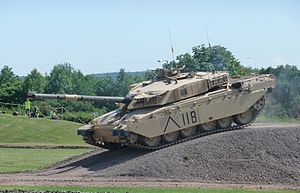- Challenger 1
-
FV 4030 Challenger 
Challenger 1 at the Tankfest 2009 at the Bovington tank museumType Main battle tank Place of origin United Kingdom Production history Manufacturer Royal Ordnance Factories Number built 420 Specifications Weight 62 tonnes Length 11.5 metres (37 ft 9 in) (Gun forward) Width 3.51 metres (11 ft 6 in) Height 2.95 metres (9 ft 8 in) Crew 4 (commander, gunner, loader, driver) Armour Chobham, classified Main
armamentRoyal Ordnance L11A5 120 mm rifled gun
64 roundsSecondary
armament7.62 mm L8A2, 7.62 mm L37A2 machine guns
4,000 roundsEngine Rolls-Royce CV12 26 litre diesel
1,200 hp (895 kW)Suspension hydropneumatic (Hydrogas) Operational
range450 kilometres (280 mi) (on road) Speed 56 kilometres per hour (35 mph) - List
- Category
MBTs Light Medium Heavy The British FV4030/4 Challenger 1, was the main battle tank (MBT) of the British Army from 1983 to the mid 1990s, when it was superseded by the Challenger 2. It is also currently used by the Jordanian Armed Forces as their main battle tank after heavy modifications. The variants for the Jordanian military are upgraded to Challenger 2 standards and are undergoing upgrades using an unmanned turret called the Falcon Turret.
Contents
History
The Challenger design by the former Military Vehicles and Engineering Establishment (MVEE) near Chobham in Surrey originated in an Iranian order for an improved version of the Chieftain line of tanks in service around the world. These were the Chieftain Mk5(P)- FV4030/1, FV4030/2 Shir (Lion)1 and 4030/3 Shir 2. With the fall of the Shah of Iran and the collapse of the UK MBT80 project, the British Army became the customer and the tank was further developed by MVEE to meet Western European requirements. For a short time the tank was named "Cheviot" before becoming "Challenger", a name reused from a cruiser tank of the Second World War.
The most revolutionary aspect of the Challenger 1 design was its Chobham armour which gave protection far superior to any monolithic Rolled Homogeneous Armour (RHA), which was the then standard of tank armour material. This armour has been adopted by others, most notably the American M1 Abrams. Additionally the Hydrogas suspension fitted provided outstanding cross-country performance through the long suspension arm travel and controlled bump and rebound behaviour offered.
The Challenger was built by the Royal Ordnance Factories (ROF). In 1986, ROF Leeds (and the Challenger production line) was acquired by Vickers Defence Systems (later Alvis Vickers).
Challenger 1 competed in the Canadian Army Trophy Competition in 1987. It scored more direct hits than its competitors[citation needed], but the poor fire control system and sights caused it to be the slowest firer, and it was placed last in the league tables.
A requirement for a new MBT was later issued. Proposals put forward for the new specification included an improved Challenger from Vickers, the American M1 Abrams, the French Leclerc, and the German Leopard 2. The Vickers Defence Systems design, designated Challenger 2, was eventually selected. This tank was significantly more capable than its predecessor, based on the same basic MVEE-designed hull but with a new turret based on the Vickers Private Venture Mk7 design and improved Chobham armour.
There was also a Challenger Marksman SPAAG version, equipped with the Marksman turret.
Operational service
180 Challenger tanks were deployed to Saudi Arabia for Operation Granby, the UK operation in the Persian Gulf War. Challengers were also used by the British Army in Bosnia and Herzegovina and Operation Joint Guardian, the NATO-led drive into Kosovo.
Operators
Current
Former
 United Kingdom, replaced by Challenger 2.
United Kingdom, replaced by Challenger 2.
Gallery
-
Challenger 1 of the Royal Scots Dragoon Guards near Kuwait City during the Gulf War.
-
Challenger 1 of the 1st The Queen's Dragoon Guards with IFOR markings.
See also
References
External links
Post-WWII British AFVsWheeled Ferret Scout Car · Fox Reconnaissance Vehicle · Saladin Armoured Car · Saracen APC · FV1611 "Pig" · Saxon · Mastiff PPV · Husky TSVAPCs and IFVs Light tanks and
anti-tank vehiclesSP artillery Main battle tanks UK unarmoured or non-fighting vehicles Categories:- Main battle tanks of Jordan
- Main battle tanks of the United Kingdom
- Main battle tanks of the Cold War
- Gulf War tanks
- Main battle tanks of the post–Cold War period
Wikimedia Foundation. 2010.



